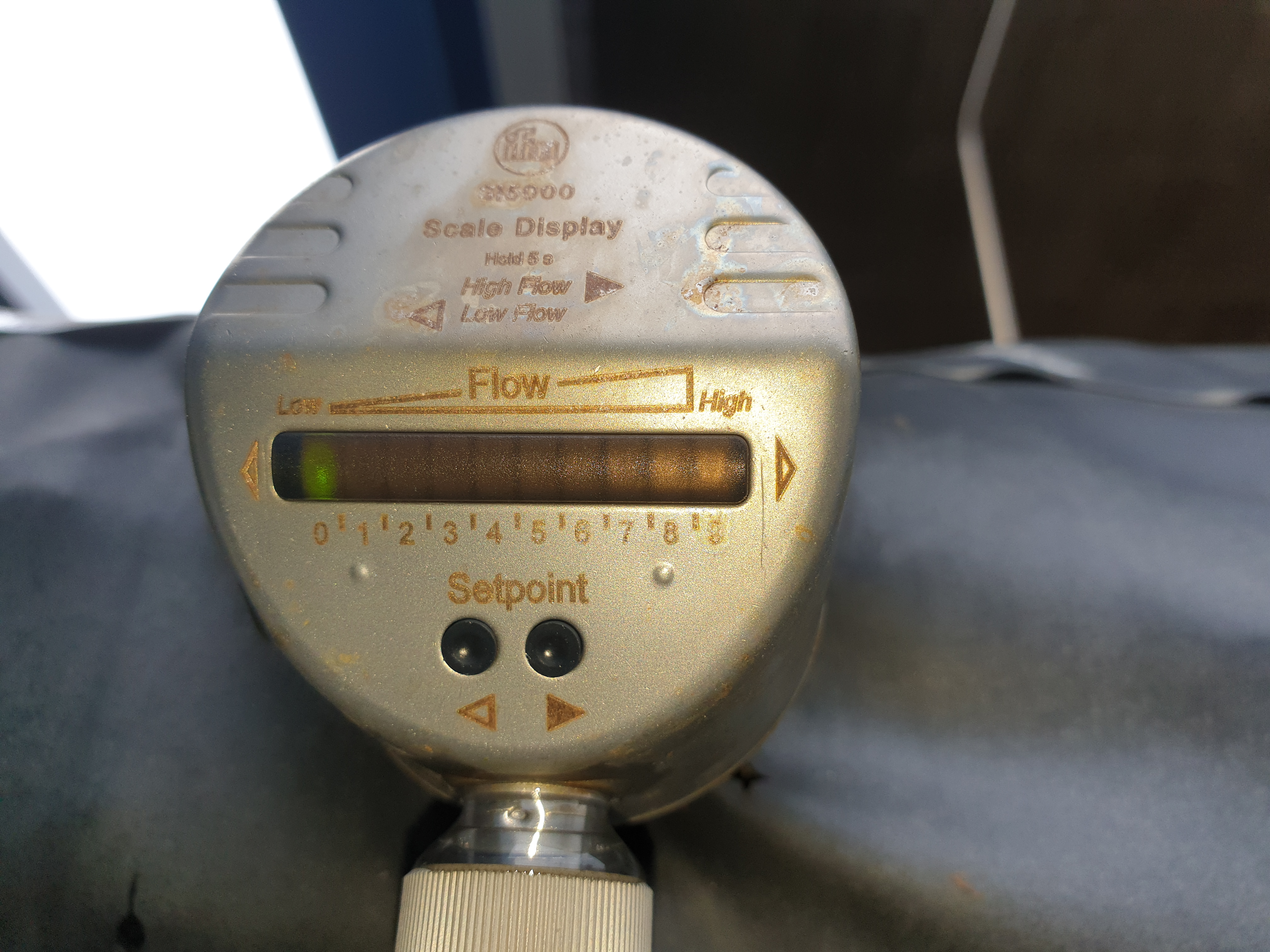Flow Switch
The chilled water system flow switch requires regular maintenance due to a to build up of contaminants on the sensor. Over time, slime accumulates giving false readings. The problem is relatively easy to sort out: a wipe with a cloth.
Retrieving the Sensor during Chilled Water System Maintenance
The more difficult part is retrieving the sensor. It is fixed with a bolt into the water system. Therefore, there is pressure inside the water system. This pressure is handled and the glycol drained into vessels.
Checking the Fault Out Level
As you can see from the picture: there is a green light on 0. This indicates that the pump is off, not to be confused with pressure. With the pump on: the green lights go all the way up to 9 with the fault out level showing red on 7. Flickering between the numbers indicates that the flow rate is starting to drop off.
Maintaining the Chilled Water System Fault Out Level
Using a terminal driver and the manual that comes with the flow switch: the buttons can be pressed a number of times to 'self test' Also, the fault out level can be set.
0161 237 3727
service@maximuschillers.com
Testing the Flow Switch
The flow switch can be manually tested according to standard industry procedures. This ensures that the switch will function correctly when it needs to.
Maximus Chillers offers the whole package for the maintenance of your plant. With state of the art equipment and the best engineers- we complete the picture. Weather you have a small problem like the above mentioned flow switch, or a big problem like compressor failure- Maximus Chillers can help.
Any Chiller- Any Problem- Any Part- Any Refrigerant- Anywhere- The MAXIMUS ADVANTAGE™
Ammonia Alarm during Chilled Water System Maintenance
This safety system has a sensor and PCB in the compressor housing and also below the condenser. They feedback to the control board which has yellow fault lights and red alarm lights. A test and reset function are also available.
Red Fault Light
On this visit, a red fault light was observed for the sensor located in the compressor housing.
Personal Protective Equipment
As a precaution, our engineer donned his breathing apparatus, ammonia resistant gloves and full length splash resistant clothing.
Ammonia Detection
When he removed the panel which gains access to the compressor housing, his ammonia detector showed a low reading of ammonia. It was low enough for him to stand away from the compressor house and remove his breathing equipment.
Leaking Shaft Seal
On inspection, the shaft seal was found to be leaking. Often a relatively easy fault to rectify. The seal requires oil from inside the system to coat the two polished glass like mating surfaces. As the system had been standing for a while, this oil had ran away.
Rectification during Chilled Water System Maintenance
Our engineer used standard industry procedures to re wet the mating surfaces and re make the seal. After run testing, his ammonia leak detector was used to re assess the shaft seal. It was found to be okay with no leaking ammonia.
0161 237 3727
service@maximuschillers.com
Fan Decks
All 8 of the condenser fans had been replaced recently as they had failed one at a time until high pressure problems had started to occur. The program has pre-set pressure values so that pairs of the fans come on at 1 bar intervals. This is a good way of controlling the fans, but it means that some of the fans will only come on when there is a high pressure issue. Rainwater can therefore ingress into the fan windings causing them to short out on start up.
Fan Rotation during Chilled Water System Maintenance
The way our engineer prevented this from happening was to rotate the fans on each maintenance from being lead to lag.
Low Oil Level during Chilled Water System Maintenance
This chiller often runs in low load conditions. When this happens, the slide valve closes to a 0% position to prevent too many compressor start ups. However, the compressor oil pump still primes the compressor bearings. The oil then lubricates the screws and is discharged from the compressor. This builds up in the discharge and so starves the oil flow to the oil separator. The result is the low oil level fault which our engineer had identified.
Start Up
The compressor has a 30 second low oil level timer on start up. This had been decided by the manufacturer of the chiller with advice from the screw compressor company. On start up with slide valve open, the oil gets pushed up into the oil separator.
Monitoring
The chiller was monitored for oil temperature and oil level related issues for the rest of the visit. The compressor temperatures were found to be nominal and in line with standard industry guidelines.
Remote Location
This is a remote job and so a long drive back for our engineer. The location of the chiller is also remote in the building. To get equipment up to the work location, it is necessary to go up in the goods lift, winch it up a cat ladder, go through a plant room and across a roof.
Related Articles:
R134a Chilling Plant Maintenance
Air Cooled Chiller Planned Maintenance
Process Chiller Maintenance Visit
Centrifugal Chiller Maintenance
Industrial Chiller Maintenance
Planned Preventative Chiller Maintenance
Air Cooled Chiller Maintenance
Preventative Chiller Maintenance
Read about flow measurement on Wikipedia

